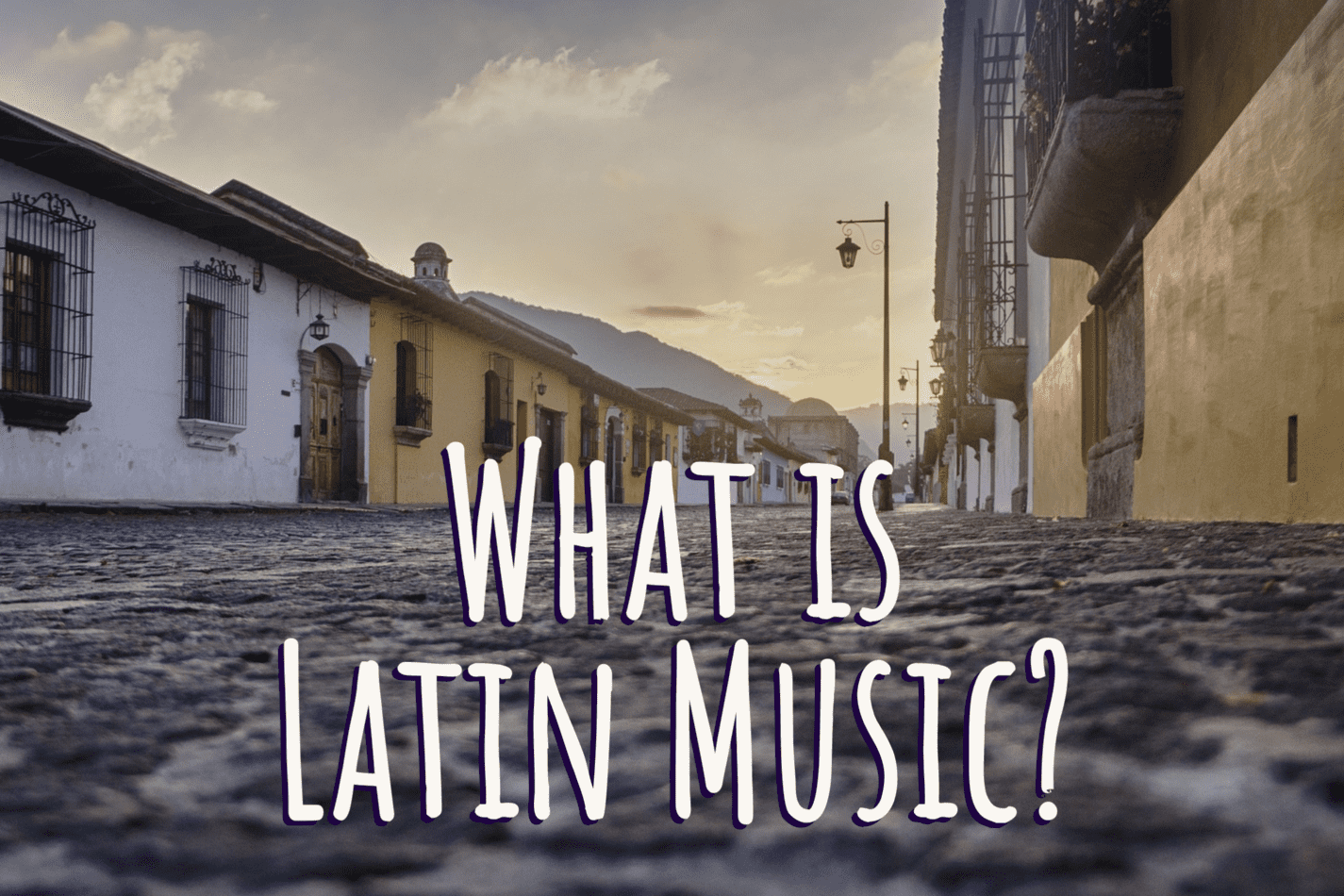If you listen to a mambo or bossa nova, it’s easy to say that it’s not the same rhythmic style. But there’s something similar about the two. We often call this generalization “Latin music,” but what is Latin music?
Latin music is from Latin America, a cultural region consisting of countries that speak Latin-based languages in the Americas. It’s a mix of mostly African rhythms and instruments, European song forms and instruments, and indigenous influences.
In this article, I’m going to talk about some of the primary elements that make up Latin music and address the generalization itself. This means that not every element can or will be addressed and that rhythms and other musical elements will be left out for the sake of staying focused on describing how something identifies as Latin music.
Which Countries Are In Latin America?
The Latin American countries include Mexico in the North of the region, the Caribbean, Central America, and South America. This can be confusing if you begin to think that it’s all just South America because you’d be leaving out the North American Latin countries like Mexico and half of the Caribbean.
The main Latin-based languages of this region include Spanish, Portuguese, and French. These languages were brought by the European conquerors who took over the native populations and the land they survived by.
Conquistadors sought resources like gold to feed the mercantilist economy of Western European monarchies in the 15th and 16th centuries. However, they found fertile land and a variety of biological diversity in the plants, animals, and people who were either wiped out by disease or used for forced labor, among other things.
When the indigenous labor supply was not enough for the Europeans, they brought slaves from Africa. This led to the mixing of another crucial element of Latin American culture.
Since the European conquest and subsequent forced migration of African slaves landed largely in places like Cuba and Brazil, these countries have become ground zero for the development of Latin music.
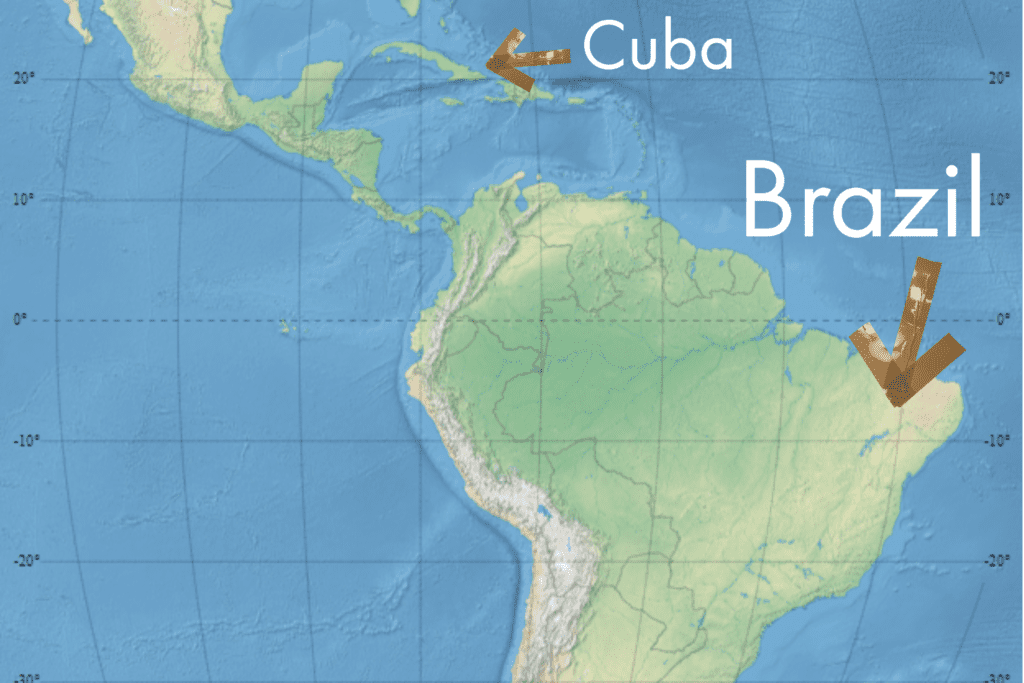
So for the majority of the following article, I will discuss music from these countries with a few other Latin American examples that are popular throughout the modern world.
Basic Elements of Latin Music
Although Latin music draws its influences from Europe, Africa, and indigenous peoples, the most significant commonalities among Latin American countries point to Africa. This is mostly because of the traditions that the segregated slave and eventually free black populations kept alive from their African heritage.
Further, many new forms of music developed after slavery was abolished. Black neighborhoods adapted African song and dance to new settings, such as European-style dance halls.
Of the many elements of Latin music that makes it regionally significant, the clave rhythm stands out the most. This rhythmic cycle comes from the African bell patterns brought through the Middle Passage of the slave trade. Various forms of clave and other elements of African bell patterns can be found in the music of Cuba and Brazil.
Clave Concept from Africa to the Americas
Clave is a two-measure rhythmic cycle that forms the basis of Cuban music, and it is the Latin rhythm to which all rhythmic ideas relate. It exemplifies two of the most important African music concepts: (1) call and response and (2) rhythmic cycles.
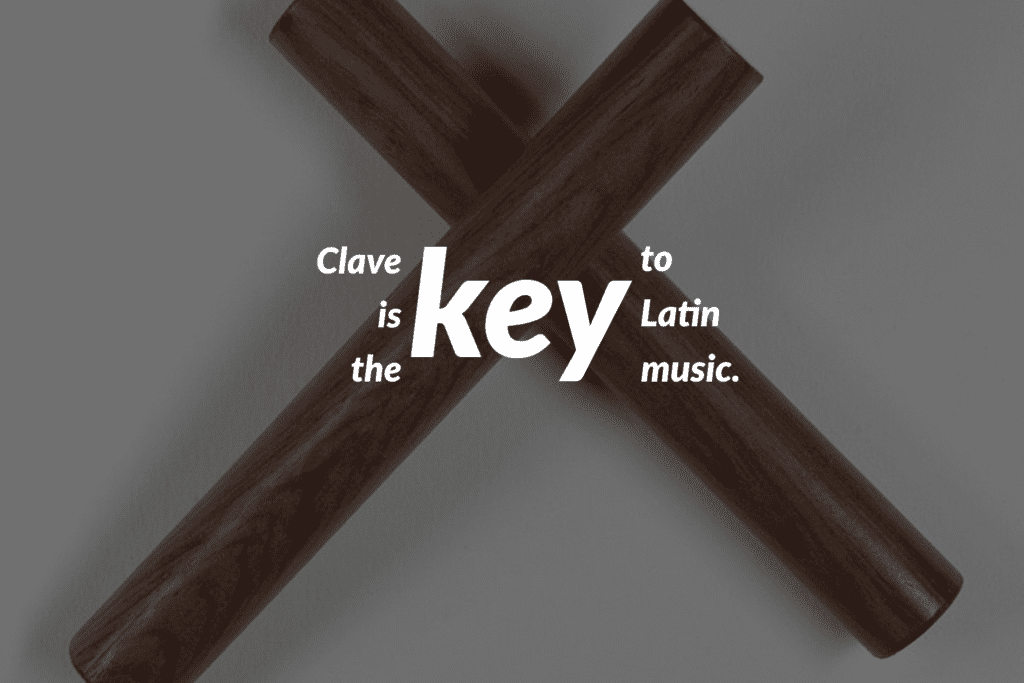
In the following examples, pay close attention to how the African bell pattern relates to the clave rhythms used in Brazilian and Cuban music. Look for the call on one side of the clave rhythm and the response on the other side.
African Bell Pattern
If clave is the key to Latin music, the African Bell Pattern is the mold from which the key was cut. And, although there are several African bell patterns, there is one that influenced all music around the world more than any other.

It’s important to feel a consistent pulse on the downbeats. This pulse, in both West Africa and Latin American music and dance, is often played by shaker or rattle instruments, such as shakere or maracas.
Feel the downbeats by tapping or stomping your foot as you play the bell pattern. If you want to practice more of a dance move to feel the pulse, you can try the following steps.

6/8 Clave
The 6/8 clave is basically the African Bell Pattern without the eighth notes. It’s not a particular common clave rhythm for Latin music, but it’s important to fully conceptualize the rumba clave and how much of Latin music is phrased.

Since the Western music tradition has been used to notate Latin music, musicologists and general consensus have agreed that the African bell is in 12/8 meter. But it’s important to note that the 6/8 clave is notated as such to outline the importance of the two sides of the clave to which vocal and instrument parts in Cuban music relate.
Rumba Clave
Rumba clave is basically the 6/8 clave in 4/4. Since African rhythms are of the oral tradition and not necessarily passed down through notation, like Western music studies, the distinction between the meters four and six is more of a shift in feel than a mathematical interpretation.

The rumba clave is used for a lot of folkloric styles. You’ll also hear it in more modern styles like songo or timba. The songo and timba were formed by combining the son montuno and folkloric rhythms along with rhythm and blues and funk.
Think of folkloric music in Cuba as a place where the rhythmic history is preserved. Musicians in Cuba learn these rhythms in both religious and secular settings, and interpretations of the rhythms vary from family to family and one neighborhood to another.
Rhythms like the rumba clave are just one of the many patterns that have bridged the transition from the music of slaves to the development of free black music — Cuban music.
Son Clave
The son clave is very similar to the rumba clave. The only difference is that the third clave hit on the three side is on the downbeat of four. For the rumba clave, the third hit is on the upbeat of count four.

Son clave is the primary clave rhythm for son montuno. This is the genre of Cuban popular music that became the foundation of salsa.
Brazilian Clave
Clave in Brazilian music is a bit different from its counterpart in Cuban music. The Brazilian clave is not as strict and can be varied a lot more.
The following examples shows the Brazilian clave as it comes from samba and bossa nova, a subgenre of samba. It’s only different from the son clave in one way — the last clave hit is shifted one eighth note to the right. This places the last clave hit on the upbeat of three.

This rhythm is played by a variety of instruments, like the caixa (snare drum) and tamborim. Within a piece of music, the rhythm can change to other variations for phrasing purposes, which is not a common characteristic in Cuban music.
Generally, the clave in Cuban music stays the same throughout an arrangement. However, with the advent of Latin jazz, incorporating both Brazilian and Cuban musical elements, a lot of modern compositions switch claves or styles for phrasing purposes.
Tresillo Rhythm and Latin Music
The tresillo is a fundamental rhythmic concept that comes from the African rhythms brought to the Americas. It literally means “triplet,” and it refers to rhythms that are in groups (or cells) of three evenly spaced notes.


This rhythm is the three-side of both the Cuban and Brazilian claves. It’s the theme of many drum breaks in samba and Afro-Cuban genres, and has been the foundation of so many popular Latin music rhythms over the last hundred and fifty years.
When you combine the tresillo and a strong consistent pulse like in the examples below, dancers and listeners can enjoy the balance of downbeats and upbeats. The rhythm starts with a strong downbeat, followed by an upbeat on beat two, and finishes with a strong downbeat on beat four.

This downbeat on four feels more like a release of the tension that the upbeat of beat two creates and takes us back to the downbeat of one more gradually. If you think about this rhythm in cut-time with a downbeat pulse on one and two (one and three for common time), this balance of downbeat and upbeat tension and release is easier to understand.
Tumbao Rhythms for Bass, Piano, and Congas
Tumbao means to lay it down. It’s a term used to describe musicians laying down a groove and stretching that groove out over a space for other instruments to build upon.
Piano, bass, and congas all play tumbaos, and, in particular, the bass and conga patterns are commonly referred to as tumbao in the Cuban tradition.
Bass tumbao comes very much from the tresillo rhythm explained above.


Phrasing in Latin Music
Latin music does not usually emphasize beat one of a measure or phrase. The phrases generally start on beat four, either the downbeat or upbeat, and accents usually fall on one level of syncopation or another. By that, I mean the syncopation produced by beat four in a cut time feel or the upbeat of beat four in common time — 4/4 time signature (see “Phrasing With Clave in Latin Music” below).
The conga pattern below starts on the upbeat before beat four.

If you listen to samba from the Brazilian music tradition, you’ll hear a strong accent with low drum sounds on beat two of a two feel. You’ll also hear high-pitched percussion, like a snare drum, accenting the upbeats. This is an example of the groove accenting different levels of syncopation that I explained previously.
The example below is a samba batucada. Look at the last line, the surdo de premeira. Notice that the open tone for this big low sounding drum. It’s on beat two of a two feel (cut-time meter).
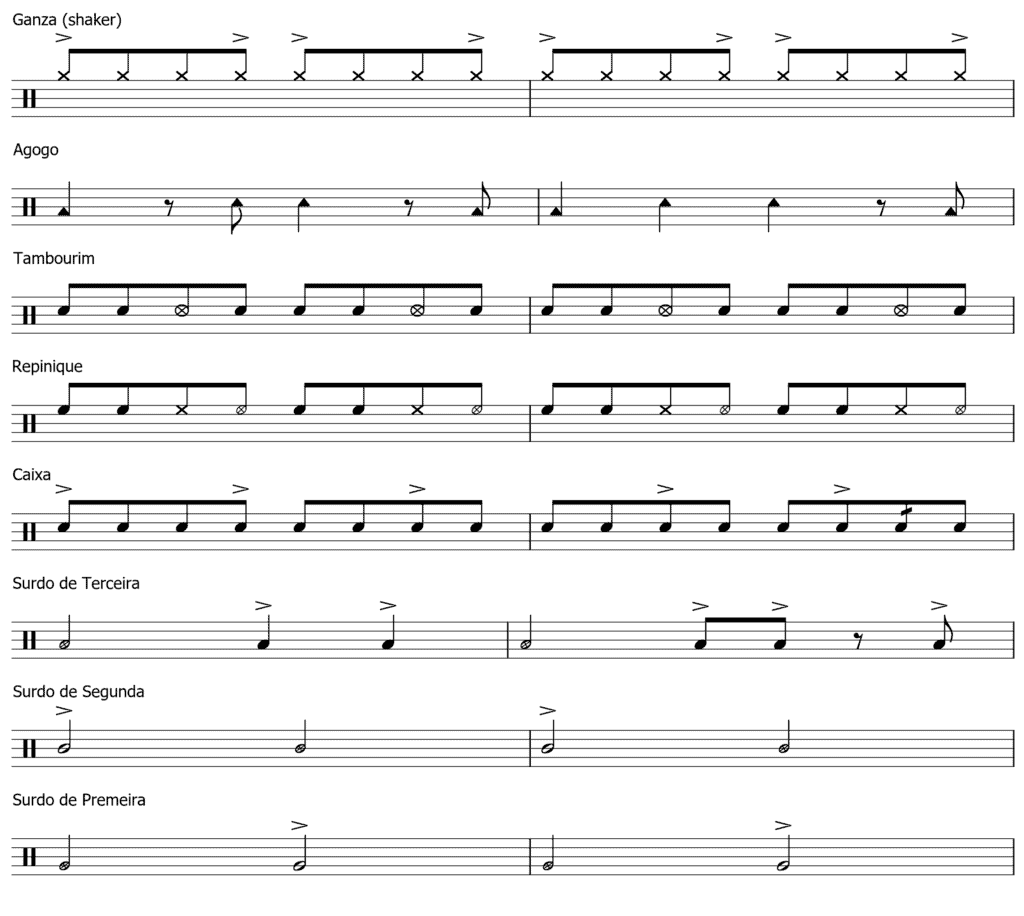
Phrasing With Clave in Latin Music
Let’s look at clave and how phrases are built around this rhythmic cycle.
The Cuban clave is a phrase composed of two distinct rhythmic cells. One cell has three hits, called the “three side,” while the other has two, and it’s called the “two side.”

The two sides of clave establish a call and response musical form, which is also apparent in Brazilian rhythms. This is one of the reasons most Latin music is more appropriately written in cut time. The meter itself outlines the two sides of the underlying rhythmic phrasing.
Additionally, clave has a couple of accents that impact the phrasing — the bombo and ponche (see image below).
The bombo is the second clave hit on the three side, and it is a low sounding long note. This means lower sound drums producing a bass sound would accent this clave hit in relation to a musical phrase.
Ponche refers to the “punch” on beat four of clave. If you listen to salsa music, you’ll hear entire ensembles accent the ponche at the end of a short or long phrase.

It’s important to understand clave phrasing because the rhythm of melodies and lyrics, for example, start and stop in relation to clave.
Latin Music is Best Written in Cut Time, Mostly
Regardless of which Latin American country’s music you listen to, you’ll almost always find a strong half note pulse. This is one of the reasons cut time is more appropriate for notating Latin music.
The other reason is based on the concept explained in the previous section — the two part rhythmic phrasing.
If you look at the two examples below, you may notice that they are rhythmically the same. One is written in common time and the other in cut time. Since this is a cascara patter is based on the Cuban clave, the two-measure cut time notation makes more musical sense for musical phrasing.


By writing the example above in cut time, it outlines the rhythmic phrasing that clave establishes. The cut time notation also honors the call and response nature of Afro-Cuban musical aesthetics.
Latin Music Styles and Genres
The list of Latin music styles and genres is very long. The following is a short list that shows the variety that different countries have to offer.
Salsa
Salsa is music based mostly on the Cuban conjunto and charanga orchestras. It’s stylistic basis comes from the Cuban son and various other styles developed in Cuba, Puerto Rico, and by mostly immigrants to the United States.
Since salsa is a genre, it’s composed of many styles. For example, you should expect to hear mambo, cha cha, bolero, and even merengue in modern salsa ensembles.
Samba
The samba genre encompasses a wide range of musical styles that developed mostly in the 20th Century. Much of the modern samba rhythms that you’ll commonly hear are based on the batucada percussion style.
Batucada Instrumentation
The batucada style includes surdos, tamborims, caixas, ganzas, and many more percussion instruments. They are called by the high-pitched drum that sounds like a small timbale played with one stick and a hand. The calls are answered by the whole ensemble, the bateria, of between 10 and 50 people, sometimes more.
Bossa Nova
A bossa nova is sort of the opposite of the batucada. It’s light and usually played by a few people. And the rhythms are from the same Brazilian approach to African percussion.
This style of the samba was created on the beaches of Rio de Janeiro in the late 1950s and was pioneered by musicians like Antônio Carlos Jobim and João Gilberto (source).
Many people will hear a bossa nova, like the example below, played by a jazz group with a drum set for the first time.

Merengue
The merengue is a musical form that dates back to the mid-19th Century in the Dominican Republic. Like Cuban and Brazilian music, it developed based on the local rhythms and instruments as well as those brought to the region from other places.
Merengue is a very popular dance music that incorporates several different traditional styles performed by some key instruments. The typical group includes accordion, stringed instruments, guira, and tambora.
For many of the merengue styles, the beat has a very Latin music characteristic to it in the form of a strong bass drum downbeat. The guira, a metal cylindrical percussion instrument that’s scraped with a comb-like implement. This provides the rattle rhythm (see below) that Latin music often incorporates from its African heritage.

Much of the merengue music you may hear in U.S. cities would be played by a Latin jazz group or a salsa ensemble. These groups add more instruments like congas to fill out and support the traditional rhythms.
Cumbia
Cumbia was developed in Columbia by Afro-indigenous mixtures of instruments, rhythms, and songs. The rhythms and songs have become more popularized and heard in modern dance halls in major cities around the world.
Other Latin American countries, like Peru and Mexico, also developed versions of cumbia music.
The following examples include some percussion rhythms that are often played in North American dance clubs.
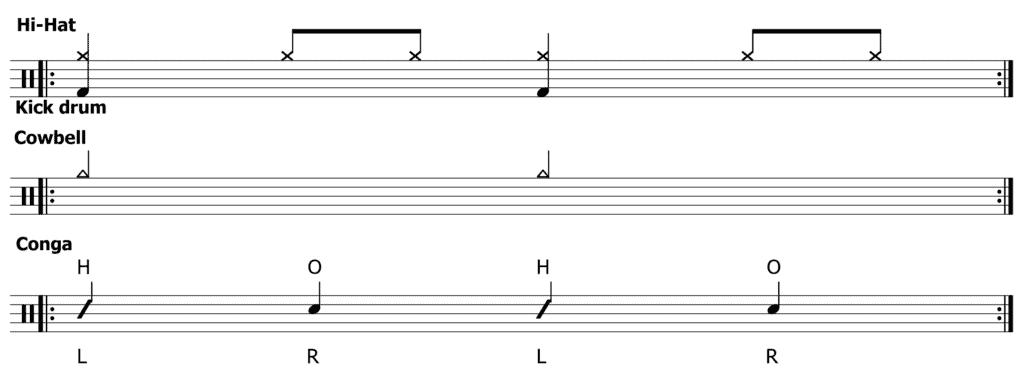
Reggaeton
Reggaeton is a dancehall style that developed in the 1990s in Puerto Rico. It’s a newer style than the others on this list. Plus, it has influenced a lot of popular music in the United States and around the world.

Latin Jazz
This is the genre of Latin music that is most open to various styles from around Latin America. Although the rhythms of Cuba and Brazil are very dominant in these types of ensembles, groups from places like Peru would incorporate Afro-Peruvian rhythms, for example.
Influence of Latin Music Around the World
If you listen to popular music from all around the world, you will hear Latin rhythms that have been infused with new ideas. The influence of Latin music is not a new thing, either.
This exchange has been developing since immigrants from Latin American countries have brought their musical traditions to places like the United States. Likewise, the spread of Latin music via the radio and records sales reached all around the world. Pop music in the United States was especially influenced by Latin music.
Richard Berry’s “Louie Louie” is a prime example of the cha cha influencing rock ’n‘ roll.
The zombies “She’s not there” … Brazilian bossa nova influence
Latin Music Listening Guide
Some of the following choices are from this Music Gateway article. Other examples come from Latin music hits that I’m familiar with from top search results. This is a short introductory list that by no means would make anyone well versed in Latin music catalogue.
Classic Latin Tunes
“Guantanamera” by Joseito Fernández
“Besame Mucho” by Luis Miguel
“Cumbanchero” by Rafael Hernandez
“Manteca” by Chano Pozo, Dizzy Gillespie, Gil Fuller
“Oye Como Va” by Tito Puente
“Quimbara” by Celia Cruz
“Periodical de Ayer” by Hector Lavoe
Modern Latin Pop
“Conga” by Gloria Estefan
“Despacito” by Luis Fonsi
“Vivir Me Vida” by Marc Anthony
“Gasolina” by Daddy Yankee
“Bailando” by Enrique Iglesias
Brazilian Favorites
“Magalehna” by Sergio Mendes
“Mas Que Nada” by George Ben
“Aguas De Março” by Elis Regina and Tom Jobim
“Beleza Rara” by Banda Eva


